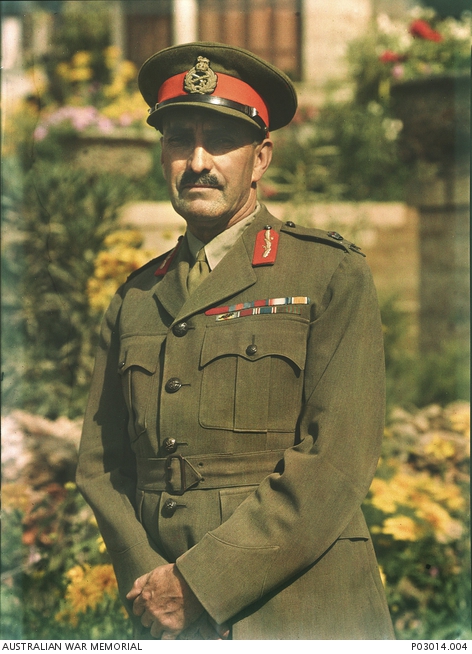| Accession Number | P03014.004 |
|---|---|
| Collection type | Photograph |
| Object type | Colour - Film original transparency (positive) other |
| Maker |
Monro, Ronald Keith Monro, Ronald Keith |
| Place made | Australia |
| Date made | c 1942 |
| Conflict |
Second World War, 1939-1945 First World War, 1914-1918 |
| Copyright |
Item copyright: Copyright expired - public domain
|
Portrait of Lieutenant General John Dudley Lavarack, Commanding Officer of the 7th Division. On 7 ...


Portrait of Lieutenant General John Dudley Lavarack, Commanding Officer of the 7th Division. On 7 August 1905 Lavarack was commissioned into the Permanent Military Forces and was appointed the rank of lieutenant, Royal Australian Artillery. He attended the Staff College in Camberley, England, from early 1913 until the outbreak of the First World War. He was promoted to the rank of brigade major of the 22nd (British) Divisional Artillery in February 1915 and was sent to France in September 1915. During May 1916 Lavarack was appointed staff officer, Royal Artillery, at the XVI Corps' headquarters. Lavarack had been appointed to the Australian Imperial Force in February 1915 and joined the Australian forces in July 1916, being posted to 2nd Division for the operations at Pozières, France. He commanded two field batteries and was brigade major of the 5th Divisional Artillery during the subsequent fighting on the Somme and the advance to the Hindenburg line. One of the few Australian officers with staff college training, he was transferred in May 1917 to the headquarters of the 1st Division where he worked under Colonel (later Field Marshal) Sir Thomas Albert Blamey. By December Lavarack was appointed the rank of lieutenant colonel of the 4th Division, commanded by Major General E G Sinclair-Maclagan. For his war service Lavarack was awarded the Distinguished Service Order (DSO) and the French Croix de Guerre. He was also mentioned in despatches on three occasions. Returning to Australia in September 1919, Lavarack was posted to the Royal Military College (RMC), Duntroon, as director of military art. In 1924 he served as a staff officer on the headquarters of the 2nd (Militia) Division and in March 1925 he was made director of military training at Army Headquarters, Melbourne. Promoted to the rank of brevet colonel in 1926, at the end of the following year he went to London to study at the Imperial Defence College. Early 1929 Lavarack was given the post of director of military operations and intelligence at Army Headquarters. In January 1933 Lavarack became commandant of the RMC and on 21 April 1935 he was promoted to temporary major general, taking over as Chief of General Staff and superseding a number of more senior officers. Against General Blamey's wishes, the Australian Government promoted Lavarack to Major General and gave him command of the 6th Division. He arrived in the Middle East in November 1940 and in March 1941 Axis forces under General Erwin Rommel attacked in Libya. The 18th Brigade of the 7th Division was rushed to Tobruk to support the 9th Australian Division under Major General Sir Leslie Morshead. Lavarack was promoted to lieutenant general on 18 June 1941 and took command of I Corps in Blamey's place. having taken the position of commander-in-chief in the Middle East. In February 1944 Lavarack flew to Washington to become head of the Australian Military Mission. He was military adviser to the Australian delegation at the United Nations Conference on International Organization held at San Francisco in April to June 1945, returning to Australia he retired from the military on 18 September 1946. The same month he retired he was appointed governor of Queensland and was sworn in on 1 October 1946. In 1951 his term was extended for another five years and there was to be a further extension of one year from 1 October 1956 but because of ill health he was relieved of his duties on 25 January 1957. Sir John Dudley Lavarack died on 4 December 1957 in Queensland, aged 72.
